Xinyue Wang
ATM-GAD: Adaptive Temporal Motif Graph Anomaly Detection for Financial Transaction Networks
Aug 28, 2025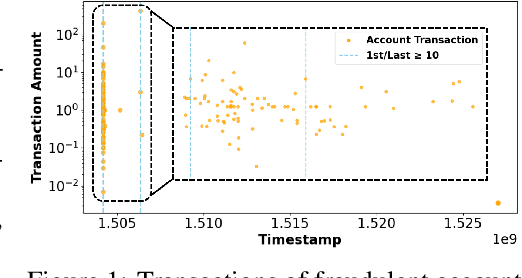

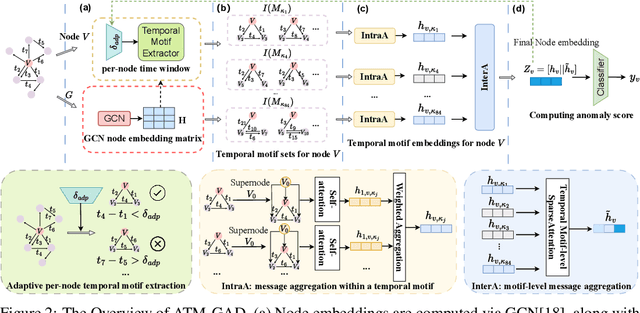

Abstract:Financial fraud detection is essential to safeguard billions of dollars, yet the intertwined entities and fast-changing transaction behaviors in modern financial systems routinely defeat conventional machine learning models. Recent graph-based detectors make headway by representing transactions as networks, but they still overlook two fraud hallmarks rooted in time: (1) temporal motifs--recurring, telltale subgraphs that reveal suspicious money flows as they unfold--and (2) account-specific intervals of anomalous activity, when fraud surfaces only in short bursts unique to each entity. To exploit both signals, we introduce ATM-GAD, an adaptive graph neural network that leverages temporal motifs for financial anomaly detection. A Temporal Motif Extractor condenses each account's transaction history into the most informative motifs, preserving both topology and temporal patterns. These motifs are then analyzed by dual-attention blocks: IntraA reasons over interactions within a single motif, while InterA aggregates evidence across motifs to expose multi-step fraud schemes. In parallel, a differentiable Adaptive Time-Window Learner tailors the observation window for every node, allowing the model to focus precisely on the most revealing time slices. Experiments on four real-world datasets show that ATM-GAD consistently outperforms seven strong anomaly-detection baselines, uncovering fraud patterns missed by earlier methods.
$PD^3F$: A Pluggable and Dynamic DoS-Defense Framework Against Resource Consumption Attacks Targeting Large Language Models
May 24, 2025Abstract:Large Language Models (LLMs), due to substantial computational requirements, are vulnerable to resource consumption attacks, which can severely degrade server performance or even cause crashes, as demonstrated by denial-of-service (DoS) attacks designed for LLMs. However, existing works lack mitigation strategies against such threats, resulting in unresolved security risks for real-world LLM deployments. To this end, we propose the Pluggable and Dynamic DoS-Defense Framework ($PD^3F$), which employs a two-stage approach to defend against resource consumption attacks from both the input and output sides. On the input side, we propose the Resource Index to guide Dynamic Request Polling Scheduling, thereby reducing resource usage induced by malicious attacks under high-concurrency scenarios. On the output side, we introduce the Adaptive End-Based Suppression mechanism, which terminates excessive malicious generation early. Experiments across six models demonstrate that $PD^3F$ significantly mitigates resource consumption attacks, improving users' access capacity by up to 500% during adversarial load. $PD^3F$ represents a step toward the resilient and resource-aware deployment of LLMs against resource consumption attacks.
Modeling Unseen Environments with Language-guided Composable Causal Components in Reinforcement Learning
May 13, 2025Abstract:Generalization in reinforcement learning (RL) remains a significant challenge, especially when agents encounter novel environments with unseen dynamics. Drawing inspiration from human compositional reasoning -- where known components are reconfigured to handle new situations -- we introduce World Modeling with Compositional Causal Components (WM3C). This novel framework enhances RL generalization by learning and leveraging compositional causal components. Unlike previous approaches focusing on invariant representation learning or meta-learning, WM3C identifies and utilizes causal dynamics among composable elements, facilitating robust adaptation to new tasks. Our approach integrates language as a compositional modality to decompose the latent space into meaningful components and provides theoretical guarantees for their unique identification under mild assumptions. Our practical implementation uses a masked autoencoder with mutual information constraints and adaptive sparsity regularization to capture high-level semantic information and effectively disentangle transition dynamics. Experiments on numerical simulations and real-world robotic manipulation tasks demonstrate that WM3C significantly outperforms existing methods in identifying latent processes, improving policy learning, and generalizing to unseen tasks.
Predicting Diabetic Macular Edema Treatment Responses Using OCT: Dataset and Methods of APTOS Competition
May 09, 2025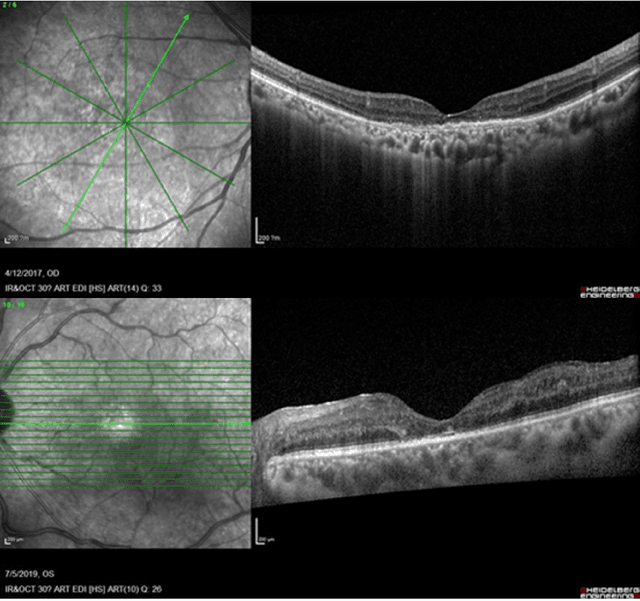
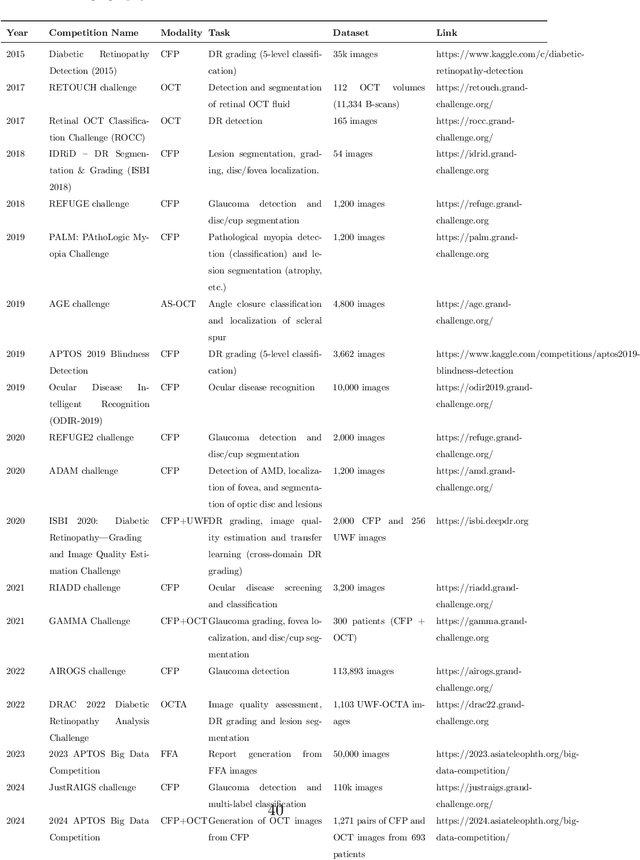
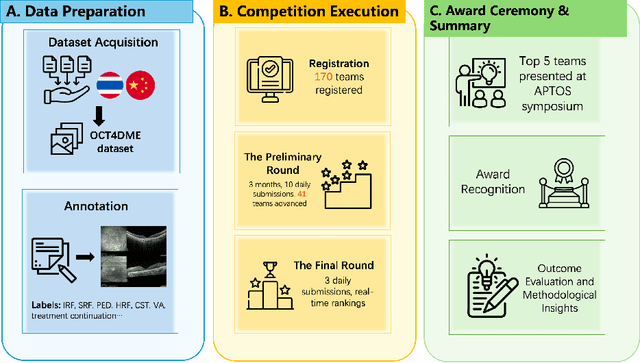

Abstract:Diabetic macular edema (DME) significantly contributes to visual impairment in diabetic patients. Treatment responses to intravitreal therapies vary, highlighting the need for patient stratification to predict therapeutic benefits and enable personalized strategies. To our knowledge, this study is the first to explore pre-treatment stratification for predicting DME treatment responses. To advance this research, we organized the 2nd Asia-Pacific Tele-Ophthalmology Society (APTOS) Big Data Competition in 2021. The competition focused on improving predictive accuracy for anti-VEGF therapy responses using ophthalmic OCT images. We provided a dataset containing tens of thousands of OCT images from 2,000 patients with labels across four sub-tasks. This paper details the competition's structure, dataset, leading methods, and evaluation metrics. The competition attracted strong scientific community participation, with 170 teams initially registering and 41 reaching the final round. The top-performing team achieved an AUC of 80.06%, highlighting the potential of AI in personalized DME treatment and clinical decision-making.
Causal-Copilot: An Autonomous Causal Analysis Agent
Apr 21, 2025Abstract:Causal analysis plays a foundational role in scientific discovery and reliable decision-making, yet it remains largely inaccessible to domain experts due to its conceptual and algorithmic complexity. This disconnect between causal methodology and practical usability presents a dual challenge: domain experts are unable to leverage recent advances in causal learning, while causal researchers lack broad, real-world deployment to test and refine their methods. To address this, we introduce Causal-Copilot, an autonomous agent that operationalizes expert-level causal analysis within a large language model framework. Causal-Copilot automates the full pipeline of causal analysis for both tabular and time-series data -- including causal discovery, causal inference, algorithm selection, hyperparameter optimization, result interpretation, and generation of actionable insights. It supports interactive refinement through natural language, lowering the barrier for non-specialists while preserving methodological rigor. By integrating over 20 state-of-the-art causal analysis techniques, our system fosters a virtuous cycle -- expanding access to advanced causal methods for domain experts while generating rich, real-world applications that inform and advance causal theory. Empirical evaluations demonstrate that Causal-Copilot achieves superior performance compared to existing baselines, offering a reliable, scalable, and extensible solution that bridges the gap between theoretical sophistication and real-world applicability in causal analysis. A live interactive demo of Causal-Copilot is available at https://causalcopilot.com/.
Diffusion Transformer Meets Random Masks: An Advanced PET Reconstruction Framework
Mar 11, 2025Abstract:Deep learning has significantly advanced PET image re-construction, achieving remarkable improvements in image quality through direct training on sinogram or image data. Traditional methods often utilize masks for inpainting tasks, but their incorporation into PET reconstruction frameworks introduces transformative potential. In this study, we pro-pose an advanced PET reconstruction framework called Diffusion tRansformer mEets rAndom Masks (DREAM). To the best of our knowledge, this is the first work to integrate mask mechanisms into both the sinogram domain and the latent space, pioneering their role in PET reconstruction and demonstrating their ability to enhance reconstruction fidelity and efficiency. The framework employs a high-dimensional stacking approach, transforming masked data from two to three dimensions to expand the solution space and enable the model to capture richer spatial rela-tionships. Additionally, a mask-driven latent space is de-signed to accelerate the diffusion process by leveraging sinogram-driven and mask-driven compact priors, which reduce computational complexity while preserving essen-tial data characteristics. A hierarchical masking strategy is also introduced, guiding the model from focusing on fi-ne-grained local details in the early stages to capturing broader global patterns over time. This progressive ap-proach ensures a balance between detailed feature preservation and comprehensive context understanding. Experimental results demonstrate that DREAM not only improves the overall quality of reconstructed PET images but also preserves critical clinical details, highlighting its potential to advance PET imaging technology. By inte-grating compact priors and hierarchical masking, DREAM offers a promising and efficient avenue for future research and application in PET imaging. The open-source code is available at: https://github.com/yqx7150/DREAM.
An Analyst-Inspector Framework for Evaluating Reproducibility of LLMs in Data Science
Feb 23, 2025Abstract:Large Language Models (LLMs) have demonstrated potential for data science tasks via code generation. However, the exploratory nature of data science, alongside the stochastic and opaque outputs of LLMs, raise concerns about their reliability. While prior work focuses on benchmarking LLM accuracy, reproducibility remains underexplored, despite being critical to establishing trust in LLM-driven analysis. We propose a novel analyst-inspector framework to automatically evaluate and enforce the reproducibility of LLM-generated data science workflows - the first rigorous approach to the best of our knowledge. Defining reproducibility as the sufficiency and completeness of workflows for reproducing functionally equivalent code, this framework enforces computational reproducibility principles, ensuring transparent, well-documented LLM workflows while minimizing reliance on implicit model assumptions. Using this framework, we systematically evaluate five state-of-the-art LLMs on 1,032 data analysis tasks across three diverse benchmark datasets. We also introduce two novel reproducibility-enhancing prompting strategies. Our results show that higher reproducibility strongly correlates with improved accuracy and reproducibility-enhancing prompts are effective, demonstrating structured prompting's potential to enhance automated data science workflows and enable transparent, robust AI-driven analysis. Our code is publicly available.
Crabs: Consuming Resrouce via Auto-generation for LLM-DoS Attack under Black-box Settings
Dec 18, 2024



Abstract:Large Language Models (LLMs) have demonstrated remarkable performance across diverse tasks. LLMs continue to be vulnerable to external threats, particularly Denial-of-Service (DoS) attacks. Specifically, LLM-DoS attacks aim to exhaust computational resources and block services. However, prior works tend to focus on performing white-box attacks, overlooking black-box settings. In this work, we propose an automated algorithm designed for black-box LLMs, called Auto-Generation for LLM-DoS Attack (AutoDoS). AutoDoS introduces DoS Attack Tree and optimizes the prompt node coverage to enhance effectiveness under black-box conditions. Our method can bypass existing defense with enhanced stealthiness via semantic improvement of prompt nodes. Furthermore, we reveal that implanting Length Trojan in Basic DoS Prompt aids in achieving higher attack efficacy. Experimental results show that AutoDoS amplifies service response latency by over 250 $\times \uparrow$, leading to severe resource consumption in terms of GPU utilization and memory usage. Our code is available at \url{https://github.com/shuita2333/AutoDoS}.
SAKA: An Intelligent Platform for Semi-automated Knowledge Graph Construction and Application
Oct 10, 2024Abstract:Knowledge graph (KG) technology is extensively utilized in many areas, and many companies offer applications based on KG. Nonetheless, the majority of KG platforms necessitate expertise and tremendous time and effort of users to construct KG records manually, which poses great difficulties for ordinary people to use. Additionally, audio data is abundant and holds valuable information, but it is challenging to transform it into a KG. What's more, the platforms usually do not leverage the full potential of the KGs constructed by users. In this paper, we propose an intelligent and user-friendly platform for Semi-automated KG Construction and Application (SAKA) to address the problems aforementioned. Primarily, users can semi-automatically construct KGs from structured data of numerous areas by interacting with the platform, based on which multi-versions of KG can be stored, viewed, managed, and updated. Moreover, we propose an Audio-based KG Information Extraction (AGIE) method to establish KGs from audio data. Lastly, the platform creates a semantic parsing-based knowledge base question answering (KBQA) system based on the user-created KGs. We prove the feasibility of the semi-automatic KG construction method on the SAKA platform.
Towards Generalizable Reinforcement Learning via Causality-Guided Self-Adaptive Representations
Jul 31, 2024Abstract:General intelligence requires quick adaption across tasks. While existing reinforcement learning (RL) methods have made progress in generalization, they typically assume only distribution changes between source and target domains. In this paper, we explore a wider range of scenarios where both the distribution and environment spaces may change. For example, in Atari games, we train agents to generalize to tasks with different levels of mode and difficulty, where there could be new state or action variables that never occurred in previous environments. To address this challenging setting, we introduce a causality-guided self-adaptive representation-based approach, called CSR, that equips the agent to generalize effectively and efficiently across a sequence of tasks with evolving dynamics. Specifically, we employ causal representation learning to characterize the latent causal variables and world models within the RL system. Such compact causal representations uncover the structural relationships among variables, enabling the agent to autonomously determine whether changes in the environment stem from distribution shifts or variations in space, and to precisely locate these changes. We then devise a three-step strategy to fine-tune the model under different scenarios accordingly. Empirical experiments show that CSR efficiently adapts to the target domains with only a few samples and outperforms state-of-the-art baselines on a wide range of scenarios, including our simulated environments, Cartpole, and Atari games.
 Add to Chrome
Add to Chrome Add to Firefox
Add to Firefox Add to Edge
Add to Edge